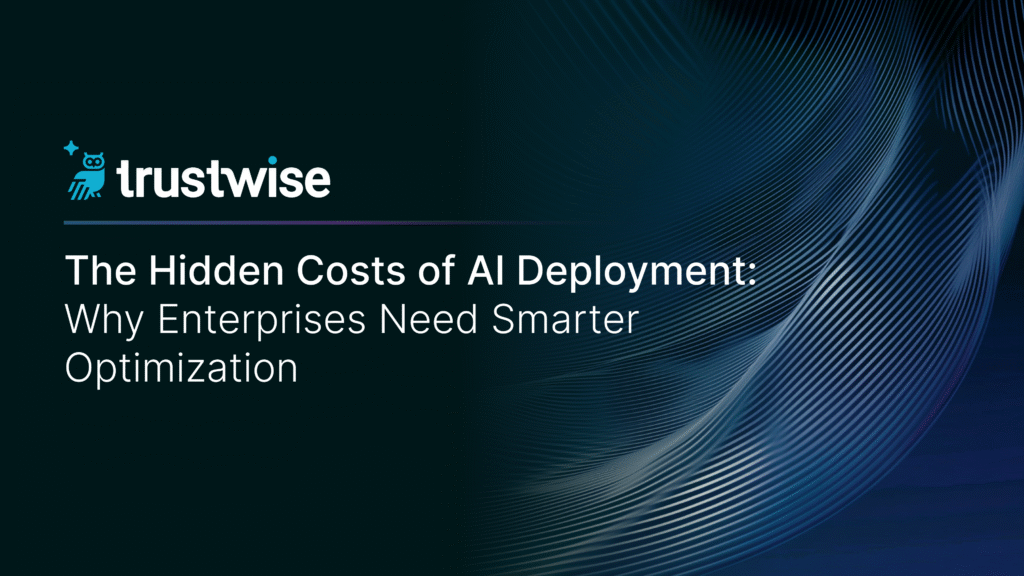
By: Matthew Barker
In the race to implement AI solutions, particularly those powered by large language models (LLMs), enterprises are discovering that beneath these impressive capabilities, there lies complex system infrastructure which harbors significant amounts of hidden cost. For example, deploying Retrieval Augmented Generation (RAG) systems is a great way to harness the power of LLMs tailored towards your enterprise documents, policies, and corporate tonality. However, without a true understanding of underlying cost mechanisms you will not be able to truly understand your return on investment (ROI) which is essential for successful, scaled and multi-year generative AI implementations.
RAG Systems Introduce Complexity, Creating Larger Issues for Enterprises
RAG systems require a surprising number of choices, parameters and hyperparameters that create significant behind-the-scenes complexity. Decision-makers often see only the final output quality but miss the intricate system dependencies.
The many different parameters enterprise RAG implementations require tuning include:
- Choice of LLM (e.g., GPT-4, Llama-3.1-8B, Gemini 2.0, Claude 3, Grok 3, Pixtral)
- Embedding model selection
- Chunk size for document processing
- Number of chunks to retrieve
- Chunk overlap settings
- Reranking thresholds
- Temperature settings for output generation
Each of these parameters can affect both performance (reliability, latency, alignment, relevancy) and cost (financial and carbon), leading to a significant amount of inter-dependency and potential trade-off when making optimal decisions in the development stage. For example, larger models may provide better quality responses, but will significantly increase computational cost and latency (i.e., response time).
What many enterprises don’t realize is that optimization of model selection and retrieval pipeline can yield reductions of up to 52% in operational costs and 50% in carbon emissions without compromising response quality. This demonstrates how poorly optimized RAG systems have dramatically inflated costs.
These technical considerations represent just one aspect of the cost equation. Another important element is how organizations approach the customization of their AI systems. Many enterprises avoid the upfront costs of fine-tuning LLMs but end up spending considerable resources on RAG optimization instead. Hyperparameter optimization for RAG systems requires evaluation across multiple objectives – cost, latency, safety, alignment – testing numerous parameter combinations, developing specialized metrics, creating synthetic test datasets and running expensive inference operations repeatedly.
These optimization challenges don’t exist in isolation; they contribute to a larger problem that mirrors traditional software development issues but with important distinctions unique to AI systems.
The Growing Concern of “AI Debt” and a Path to Cost Reduction
Just as software companies grapple with technical debt, organizations implementing AI solutions face what could be termed “AI debt,” and it’s potentially more insidious than its traditional counterpart. AI technical debt extends beyond just code to encompass the entire AI system ecosystem. The integration of foundation models adds significant infrastructure demands and creates new forms of technical debt through system dependencies that evolve over time, infrastructure complexity, documentation challenges, and continuous alignment and evaluation demands.
To avoid AI debt, organizations should adopt an AI system management approach rather than focusing solely on models. This means developing robust monitoring systems, documenting system dependencies, integrating risk management frameworks and considering the entire lifecycle of AI applications. When choosing the best RAG configuration, it’s essential to consider the downstream effects on cost, response quality and latency. These downstream effects are challenging to predict in isolation and hence require an end-to-end system optimization approach.
The benefits of this approach can be illustrated through a practical example: a restaurant deploying a RAG system for food menu ordering could identify configurations that meet their latency requirements (<2 seconds per query) and cost constraints (<$0.05 per query). Only those configurations would then undergo expensive human-in-the-loop safety evaluations, potentially reducing evaluation cost and time by 60-70%.
As the field of AI continues to mature, new optimization approaches are emerging to address these challenges in increasingly sophisticated ways.
The Evolution of AI Deployment and How Organizations Can Optimize Their Development
The AI optimization landscape is rapidly evolving with promising developments that could transform enterprise deployment economics, even as organizations grapple with significant indirect costs beyond computational expenses. Automated optimization frameworks are streamlining the traditionally manual parameter tuning process, while system-level performance metrics are enabling more holistic evaluation of AI pipelines. Perhaps most promising is the shift toward right-sized models, as organizations discover that carefully tuned smaller models (3B-8B parameters) can often match their larger counterparts for specific tasks at a fraction of the cost, creating opportunities for both economic and environmental efficiency gains.
Yet these optimization trends must be balanced against the less visible but equally important indirect costs of AI deployment. The environmental impact of LLMs presents growing concerns, with significant carbon footprints associated with both training and inference. Simultaneously, emerging regulatory frameworks like the EU AI Act and NIST AI Risk Management Framework (AI RMF) are creating substantial risk management overhead, requiring ongoing monitoring and specialized governance expertise.
Organizations must develop comprehensive governance policies while implementing proper security monitoring to address LLM vulnerabilities. Successful enterprises will systematically address both optimization opportunities and hidden costs by treating AI systems as assets requiring ongoing management. As AI integration continues, understanding the full cost spectrum becomes essential for:
- Maximizing investment value while minimizing unexpected expenses
- Adopting smarter optimization approaches to reduce AI technical debt
- Balancing performance, cost and sustainability
- Aligning systems with business objectives and responsible AI principles
The future of enterprise AI deployment depends not only on having the most advanced models, but also on creating optimized systems that holistically address these considerations in a sustainable way.

